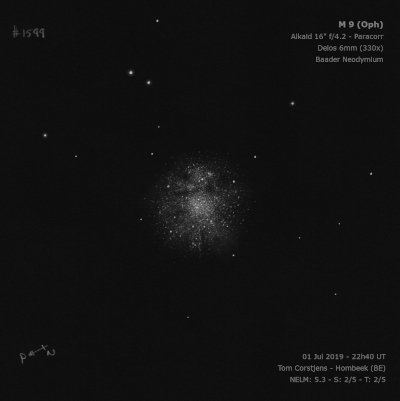
Charles Messier discovered M9 = NGC 6333 = h1979 on 28 May 1764 and recorded a "Nebula, without star, in the right leg of Ophiuchus; it is round and its light is faint. Diam. 3 arc-minutes".
William Herschel first observed this globular on 3 May 1783 with an 8-inch (10-foot focal length) and noted, "With a power of 250, I see several stars in it, and make no doubt a higher power, and more light, will resolve it all into stars. This seems to be a good nebula for the purpose of establishing the connection between nebulae and clusters of stars in general." Using his 18.7-inch on 18 June 1784 (sweep 230) at 157x, he recorded "A vL and vB cluster of excessively compressed stars. The stars are but just visible, and are of unequal magnitudes: the large stars are red; and the cluster is a miniature of [M53]. Again on 28 May 1786, he reported "a cluster of extremely compressed, excessively small stars, with a very few scattered one chiefly to the north of it."
200/250mm - 8" (6/19/82): very mottled, few stars resolved at edges at high power especially on the east side. Dark nebula B64 is close SW. NGC 6356 lies 75' NE and NGC 6342 75' SSE.
300/350mm - 13.1" (6/19/82): the central region is very bright and mottled. A number of faint stars are resolved in the outer region of the core at 150x as well as a number of stragglers.
400/500mm - 17.5" (8/1/92): at 220x, bright, fairly large, 4' diameter. The bright core is elongated N-S somewhat like M4. The outliers or unrelated field stars appear to extend the halo E-W. The halo is fairly well resolved into two dozen mag 13.5-14.5 stars. The core is very mottled and lively and just breaks up into numerous, densely packed mag 14-15 stars. At 420x, the core is easily well-resolved and two very close double stars are at the west and east edges of the halo. The dark nebula B64 lies close SW.
Notes by Steve Gottlieb